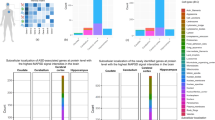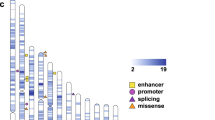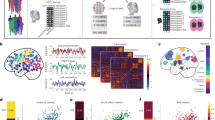Abstract
Autism spectrum disorder (ASD) is known to be a heritable neurodevelopmental disorder affecting more than 1% of the population but in the majority of ASD cases, the genetic cause has not been identified. Parent-of-origin effects have been highlighted as an important mechanism in the pathology of neurodevelopmental disorders such as Prader–Willi and Angelman syndrome, with individuals with these syndromes often exhibiting ASD symptoms. Consequently, systematic investigation of these effects in ASD is clearly an important line of investigation in elucidating the underlying genetic mechanisms. Using estimation of maternal, imprinting and interaction effects using multinomial modelling (EMIM), we simultaneously investigated imprinting, maternal genetic effects and associations in the Autism Genome Project and Simons Simplex Consortium genome-wide association data sets. To avoid using the overly stringent genome-wide association study significance level, we used a Bayesian threshold that takes into account the sample size, allele frequency and any available prior knowledge. Between the two data sets, we identified a total of 18 imprinting effects and 68 maternal genetic effects that met this Bayesian threshold criteria, but none met the threshold in both data sets. We identified imprinting and maternal genetic effects for regions that have previously shown evidence for parent-of-origin effects in ASD. Together with these findings, we have identified maternal genetic effects not previously identified in ASD at a locus in SHANK3 on chromosome 22 and a locus in WBSCR17 on chromosome 7 (associated with Williams syndrome). Both genes have previously been associated with ASD.
Similar content being viewed by others
Log in or create a free account to read this content
Gain free access to this article, as well as selected content from this journal and more on nature.com
or
References
Hallmayer J, Cleveland S, Torres A et al: Genetic heritability and shared environmental factors among twin pairs with autism. Arch Gen Psychiatry 2011; 68: 1095–1102.
Gaugler T, Klei L, Sanders SJ et al: Most genetic risk for autism resides with common variation. Nat Genet 2014; 46: 881–885.
Anney R, Klei L, Pinto D et al: A genome-wide scan for common alleles affecting risk for autism. Hum Mol Genet 2010; 19: 4072–4082.
Anney R, Klei L, Pinto D et al: Individual common variants exert weak effects on the risk for autism spectrum disorderspi. Hum Mol Genet 2012; 21: 4781–4792.
Chaste P, Klei L, Sanders SJ et al: A genomewide association study of autism using the Simons Simplex Collection: does reducing phenotypic heterogeneity in autism increase genetic homogeneity? Biol Psychiatry 2014; 77: 775–784.
Sanders S, He X, Willsey JA et al: Insights into Autism Spectrum Disorder genomic architecture and biology from 71 risk loci. Neuron 2015; 87: 1215–1233.
Chaste P, Leboyer M : Autism risk factors: genes, environment, and gene-environment interactions. Dialogues Clin Neurosci 2012; 14: 281–292.
Guilmatre A, Sharp A : Parent of origin effects. Clin Genet 2012; 81: 201–209.
Falls J, Pulford D, Wylie A et al: Genomic imprinting: implications for human disease. Am J Pathol 1999; 154: 635–647.
Gurrier F, Accadia M : Genetic imprinting: the paradigm of prader-willi and angelman syndromes. Endocr Dev 2009; 14: 20–28.
Veltman MWM, Craig EE, Bolton PF : Autism spectrum disorders in Prader-Willi and Angelman syndromes: a systematic review. Psychiatr Genet 2005; 15: 243–254.
Schanen NC : Epigenetics of autism spectrum disorders. Hum Mol Genet 2006; 15: R138–R150.
Williams TA, Mars AE, Buyske SG et al: Risk of autistic disorder in affected offspring of mothers with a glutathione S-transferase P1 haplotype. Arch Pediatr Adolesc Med 2007; 161: 356–361.
Johnson WG, Buyske S, Mars AE et al: HLA-DR4 as a risk allele for autism acting in mothers of probands possibly during pregnancy. Arch Pediatr Adolesc Med 2009; 163: 542–546.
Constantino JN, Todorov A, Hilton C et al: Autism recurrence in half siblings: strong support for genetic mechanisms of transmission in ASD. Mol Psychiatry 2013; 18: 137–138.
Sandin S, Lichtenstein P, Kuja-Halkola R, Larsson H, Hultman CM, Reichenberg A : The familial risk of autism. JAMA 2014; 311: 1770–1777.
Lawson Ha, Cheverud JM, Wolf JB : Genomic imprinting and parent-of-origin effects on complex traits. Nat Rev Genet 2013; 14: 609–617.
Tsang KM, Croen LA, Torres AR et al: A genome-wide survey of transgenerational genetic effects in autism. PloS One 2013; 8: e76978.
Yuan H, Dougherty JD : Investigation of maternal genotype effects in autism by genome- wide association. Autism Res 2014; 7: 245–253.
Cordell H, Barratt B, Clayton D : Case/pseudocontrol analysis in genetic association studies: a unified framework for detection of genotype and haplotype associations, gene-gene and gene-environment interactions, and parent-of-origin effects. Genet Epidemiol 2004; 26: 167–185.
Wolf J, Wade M : What are maternal effects (and what are they not)? Philos Trans R Soc Lond B Biol Sci 2009; 10: 1107–1115.
Connolly S, Heron EA : Review of statistical methodologies for the detection of parent- of-origin effects in family trio genome-wide association data with binary disease traits. Brief Bioinform 2014; 16: 429–448.
Ainsworth H, Unwin J, Jamison D et al: Investigation of maternal effects, maternal-fetal interactions and parent-of-origin effects (imprinting), using mothers and their offspring. Genet Epidemiol 2011; 35: 19–45.
Howey R, Cordell H : PREMIM and EMIM: tools for estimation of maternal, imprinting and interaction effects using multinomial modelling. BMC Bioinformatics 2012; 13: 149.
Wakefield J : Commentary: genome-wide significance thresholds via Bayes factors. Int J Epidemiol 2012; 41: 286–291.
Ioannidis JPA, Thomas G, Daly MJ : Validating, augmenting and refining genome-wide association signals. Nat Rev Genet 2009; 10: 318–329.
Fischbach GD, Lord C : The Simons Simplex Collection: a resource for identification of autism genetic risk factors. Neuron 2010; 68: 192–195.
Sanders SJ, Ercan-Sencicek GA, Hus V et al: Multiple recurrent de novo CNVs, including duplications of the 7q11.23 Williams syndrome region, are strongly associated with autism. Neuron 2011; 70: 863–885.
Howey R, Mamasoula C, Töpf A et al: Increased power for detection of parent-of-origin effects via the use of haplotype estimation. Am J Hum Genet 2015; 97: 419–434.
Johansen CT, Wang J, McIntyre AD et al: Excess of rare variants in non-genome-wide association study candidate genes in patients with hypertriglyceridemia. Circ Cardiovasc Genet 2012; 5: 66–72.
Wakefield J, Skrivankova V, Hsu FC, Sale M, Heagerty P : Detecting signals in pharmacogenomic genome-wide association studies. Pharmacogenomics J 2014; 14: 309–315.
Smith J, Newton-Cheh C : Genome-wide association study in humans. Methods Mol Biol 2009; 573: 231–258.
Sanders SJ, Murtha MT, Gupta AR et al: De novo mutations revealed by whole-exome sequencing are strongly associated with autism. Nature 2012; 485: 237–241.
Iossifov I, Ronemus M, Levy D et al: De novo gene disruptions in children on the autistic spectrum. Neuron 2012; 74: 285–299.
Nudel R, Simpson NH, Baird G et al: Genome-wide association analyses of child genotype effects and parent-of-origin effects in specific language impairment. Genes Brain Behav 2014; 13: 418–429.
Gosso MF, van Belzen M, de Geus EJC et al: Association between the CHRM2 gene and intelligence in a sample of 304 Dutch families. Genes Brain Behav 2006; 5: 577–584.
Peça J, Feliciano C, Ting JT et al: Shank3 mutant mice display autistic-like behaviours and striatal dysfunction. Nature 2011; 472: 437–442.
Francke U : Williams-Beuren syndrome:genes and mechanisms. Hum Mol Genet 1999; 8: 1947–1954.
Klein-Tasman BP, Phillips KD, Lord C, Mervis CB, Gallo FJ : Overlap with the autism spectrum in young children with Williams syndrome. J Dev Behav Pediatr 2009; 30: 289–299.
Tordjman S, Anderson GM, Botbol M et al: Autistic disorder in patients with Williams-Beuren syndrome: a reconsideration of the Williams-Beuren syndrome phenotype. PloS One 2012; 7: e30778.
Chen YZ, Matsushita M, Girirajan S et al: Evidence for involvement of GNB1L in autism. Am J Med Genet B Neuropsychiatr Genet 2012; 159B: 61–71.
Kraft P, Zeggini E, Ioannidis JP : Replication in genome-wide association studies. Stat Sci 2010; 24: 561.
Bush WS, Moore JH : Chapter 11: Genome-wide association studies. PLoS Comput Biol 2012; 8: e1002822.
Klei L, Sanders SJ, Murtha MT et al: Common genetic variants, acting additively, are a major source of risk for autism. Mol Autism 2012; 3: 9.
Neale BM, Kou Y, Liu L et al: Patterns and rates of exonic de novo mutations in autism spectrum disorders. Nature 2012; 485: 242–245.
Pinto D, Pagnamenta AT, Klei L et al: Functional impact of global rare copy number variation in autism spectrum disorders. Nature 2010; 466: 368–372.
Gerdts JA, Bernier R, Dawson G, Estes A : The broader autism phenotype in simplex and multiplex families. J Autism Dev Disord 2013; 43: 1597–1605.
Bernier R, Gerdts J, Munson J, Dawson G, Estes A : Evidence for broader autism phenotype characteristics in parents from multiple-incidence autism families. Autism Res 2012; 5: 13–20.
Durand CM, Betancur C, Boeckers TM et al: Mutations in the gene encoding the synaptic scaffolding protein SHANK3 are associated with autism spectrum disorders. Nat Genet 2007; 39: 25–27.
Leblond CS, Nava C, Polge A et al: Meta-analysis of SHANK Mutations in Autism Spectrum Disorders: a gradient of severity in cognitive impairments. PLoS Genet 2014; 10: e1004580.
Acknowledgements
The authors are grateful to all of the families for participating in the AGP, as well as the principal investigators, AGRE and the AGP funders: Autism Speaks (USA), the Medical Research Council (UK), the Health Research Board (Ireland), the National Institutes of Health (USA), Genome Canada, the Canadian Institutes of Health Research and the Hilibrand Foundation. The AGP data sets can be obtained from dbGaP at http://www.ncbi.nlm.nih.gov/gap. The authors are grateful to all of the families at the participating SSC sites, as well as the principal investigators (A Beaudet, R Bernier, J Constantino, E Cook, E Fombonne, D Geschwind, R Goin-Kochel, E Hanson, D Grice, A Klin, D Ledbetter, C Lord, C Martin, D Martin, R Maxim, J Miles, O Ousley, K Pelphrey, B Peterson, J Piggot, C Saulnier, M State, W Stone, J Sutcliffe, C Walsh, Z Warren and E Wijsman), and appreciate obtaining access to phenotypic data on SFARI Base. Approved researchers can obtain the SSC population data set described in this study by applying at https://base.sfari.org. In particular, We acknowledge S Sanders for his help with the SSC data. We acknowledge the support of the Trinity Centre for High Performance Computing. SC acknowledges the funding received from a Trinity College Dublin Studentship Award.
Summary data results are available at http://www.gwascentral.org/study/HGVST1842.
Author information
Authors and Affiliations
Corresponding author
Ethics declarations
Competing interests
The authors declare no conflict of interest.
Additional information
Supplementary Information accompanies this paper on European Journal of Human Genetics website
Supplementary information
Rights and permissions
About this article
Cite this article
Connolly, S., Anney, R., Gallagher, L. et al. A genome-wide investigation into parent-of-origin effects in autism spectrum disorder identifies previously associated genes including SHANK3. Eur J Hum Genet 25, 234–239 (2017). https://doi.org/10.1038/ejhg.2016.153
Received:
Revised:
Accepted:
Published:
Issue date:
DOI: https://doi.org/10.1038/ejhg.2016.153
This article is cited by
-
Evidence for parent-of-origin effects in autism spectrum disorder: a narrative review
Journal of Applied Genetics (2023)
-
A family-based study of genetic and epigenetic effects across multiple neurocognitive, motor, social-cognitive and social-behavioral functions
Behavioral and Brain Functions (2022)
-
Whole-genome sequencing reveals the genetic mechanisms of domestication in classical inbred mice
Genome Biology (2022)
-
A profile and review of findings from the Early Markers for Autism study: unique contributions from a population-based case–control study in California
Molecular Autism (2021)
-
Quantitative genome-wide association analyses of receptive language in the Danish High Risk and Resilience Study
BMC Neuroscience (2020)



